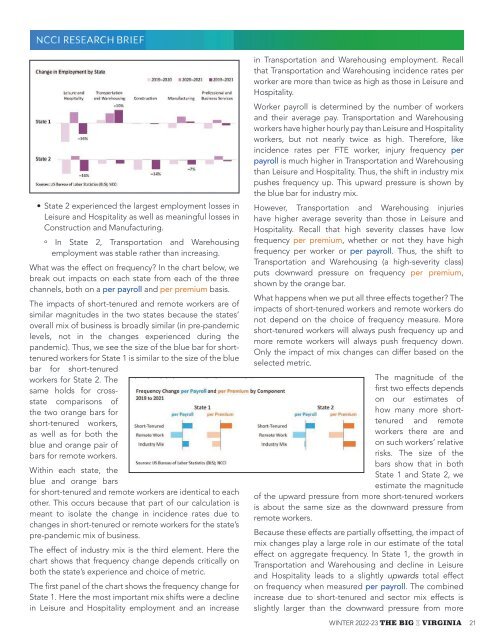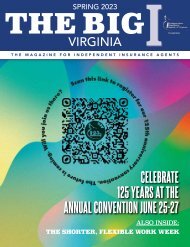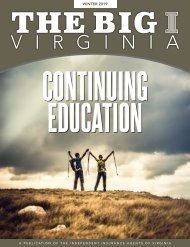The Big I Virginia Winter 2022-23
You also want an ePaper? Increase the reach of your titles
YUMPU automatically turns print PDFs into web optimized ePapers that Google loves.
in Transportation and Warehousing employment. Recall<br />
Introduction<br />
that Transportation and Warehousing incidence rates per<br />
worker are more than twice as high as those in Leisure and<br />
<strong>The</strong> Great Reshuffle is reshaping the US labor market. Unemployment is historically low, but labor force<br />
Hospitality.<br />
participation is still lower than the pre-pandemic rate. Labor shortages have led to wage growth, especially<br />
Worker payroll is determined by the number of workers<br />
strong among low-wage workers and in sectors like Leisure and Hospitality.<br />
and their average pay. Transportation and Warehousing<br />
Quit rates jumped in the middle of 2021 and remain high workers at the have time higher of this hourly writing—about pay than Leisure 50 million and Hospitality quits a<br />
workers, but not nearly twice as high. <strong>The</strong>refore, like<br />
year, almost 10 million more than pre-pandemic averages. Many workers are new to their jobs. Some of these<br />
incidence rates per FTE worker, injury frequency per<br />
are moving from one similar job to another, but others are changing industries or occupations. At the same<br />
payroll is much higher in Transportation and Warehousing<br />
time, there are a large number of new remote workers. than Many Leisure people and left Hospitality. the office Thus, at COVID’s the shift onset; in industry there mix has<br />
been a trickle back, representing a massive change in the pushes amount frequency of remote up. This work upward compared pressure to before is shown the by<br />
pandemic.<br />
the blue bar for industry mix.<br />
• State 2 experienced the largest employment losses in However, Transportation and Warehousing injuries<br />
How Leisure do and such Hospitality large changes as well in as the meaningful labor market losses impact in workers compensation injury frequency? <strong>The</strong> magnitude<br />
have higher average severity than those in Leisure and<br />
of Construction these impacts and relies Manufacturing. on the interaction of three factors: Hospitality. Recall that high severity classes have low<br />
º In State 2, Transportation and Warehousing frequency per premium, whether or not they have high<br />
• How much more or less likely are short-tenured or remote workers to be injured than other workers?<br />
employment was stable rather than increasing. frequency per worker or per payroll. Thus, the shift to<br />
• How much has the share of such workers changed? Transportation and Warehousing (a high-severity class)<br />
What was the effect on frequency? In the chart below, we<br />
• How has the sector mix of the workforce changed puts during downward the pandemic? pressure on frequency per premium,<br />
break out impacts on each state from each of the three<br />
shown by the orange bar.<br />
channels, both on a per payroll and per premium basis.<br />
What happens when we put all three effects together? <strong>The</strong><br />
<strong>The</strong> impacts of short-tenured and remote workers are of<br />
impacts of short-tenured workers and remote workers do<br />
similar magnitudes in the two states because the states’<br />
not depend on the choice of frequency measure. More<br />
overall mix of business is broadly similar (in pre-pandemic<br />
short-tenured workers will always push frequency up and<br />
levels, not in the changes experienced during the<br />
more remote workers will always push frequency down.<br />
pandemic). Thus, we see the size of the blue bar for shorttenured<br />
workers for State 1 is similar to the size of the blue<br />
Only the impact of mix changes can differ based on the<br />
selected metric.<br />
bar for short-tenured<br />
workers for State 2. <strong>The</strong><br />
same holds for crossstate<br />
<strong>The</strong> magnitude of the<br />
first two effects depends<br />
comparisons of<br />
on our estimates of<br />
the two orange bars for<br />
how many more shorttenured<br />
and remote<br />
short-tenured workers,<br />
as well as for both the<br />
workers there are and<br />
blue and orange pair of<br />
on such workers’ relative<br />
bars for remote workers.<br />
risks. <strong>The</strong> size of the<br />
bars show that in both<br />
Within each state, the<br />
State 1 and State 2, we<br />
blue and orange bars<br />
estimate the magnitude<br />
for short-tenured and remote workers are identical to each<br />
of the upward pressure from more short-tenured workers<br />
other. This occurs because that part of our calculation is<br />
is about the same size as the downward pressure from<br />
meant to isolate the change in incidence rates due to<br />
remote workers.<br />
changes in short-tenured or remote workers for the state’s<br />
pre-pandemic mix of business.<br />
Because these effects are partially offsetting, the impact of<br />
mix changes play a large role in our estimate of the total<br />
<strong>The</strong> effect of industry mix is the third element. Here the<br />
effect on aggregate frequency. In State 1, the growth in<br />
chart shows that frequency change depends critically on<br />
Transportation and Warehousing and decline in Leisure<br />
both the state’s experience and choice of metric.<br />
and Hospitality leads to a slightly upwards total effect<br />
<strong>The</strong> first panel of the chart shows the frequency change for<br />
State 1. Here the most important mix shifts were a decline<br />
in Leisure and Hospitality employment and an increase<br />
on frequency when measured per payroll. <strong>The</strong> combined<br />
increase due to short-tenured and sector mix effects is<br />
slightly larger than the downward pressure from more<br />
WINTER <strong>2022</strong>-<strong>23</strong> THE BIG I VIRGINIA 21

















